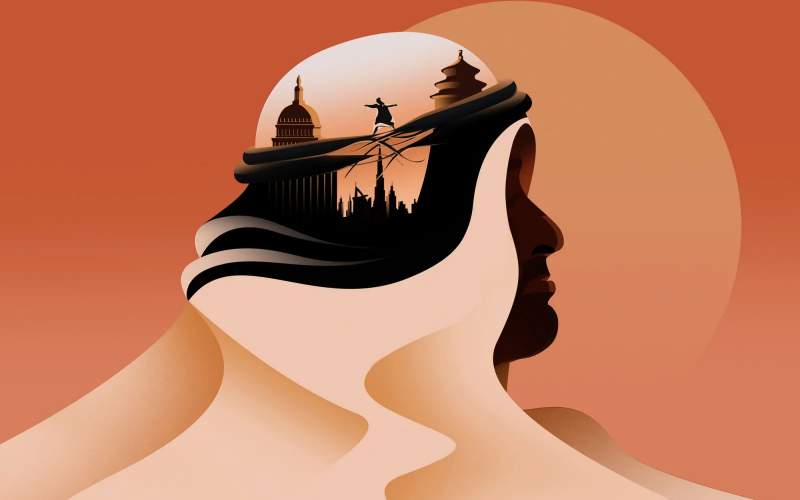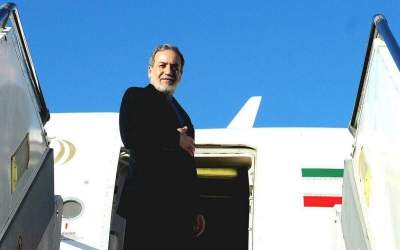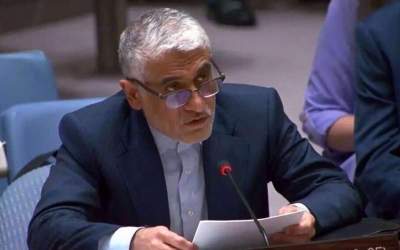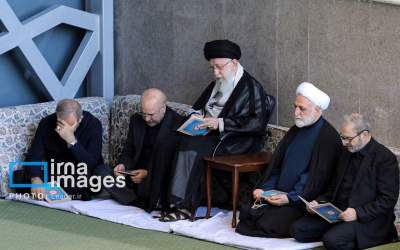The Iran Project
: How the United Arab Emirates Is Plotting Its Rise
Saturday 30 December 2023 - 19:26
Story Code : 410373
Source : Foreign Affairs Magazine
The Medicis of the Middle East?
By Neil Quilliam and Sanam Vakil
The UAE has clear ambitions: instead of being known primarily as a regional player, the UAE wants to be more like Singapore, deploying global and economic power dramatically disproportionate to its size and helping offset its geographic vulnerability. To that end, the country has cut new trade deals, invested in overseas projects, and turned itself into a tourist destination and transportation and logistics hub.
Should the UAE deliver on its ambitions, analysts searching for an apt comparision may have to look to the Medicis, the dynastic powerhouse that ruled Florence from the fifteenth through the eighteenth centuries. The Medicis did not govern much territory and were never at the center of Europe’s conflicts. But the family became a major player by using trade and banking to influence the larger empires in its neighborhood. They established an enduring alliance with France, maintained strong diplomatic ties with England, and fostered connections with the Holy Roman Empire. Florence became a focal point for economic activity, scientific discovery, and cultural achievement, including by funding Galileo and Michelangelo.
The UAE brings plenty of advantages of this effort: a well-educated population, a location halfway between the world’s biggest economies, substantial reserves of oil and gas, and, relatedly, outlandish wealth. It has a secular governance model and, unlike its neighbors, is relatively tolerant of different faiths. The UAE is part of U.S. President Joe Biden’s vision for a Middle East economic corridor that connects India and Europe. It has strong ties with other emerging middle powers, such as Brazil, India, and Indonesia, thanks to its investments in their markets. It has even normalized ties with Israel, a historic adversary. And despite Hamas’s attack and the popular but contained outcry against the war in Gaza, Israel and the UAE are maintaining economic and diplomatic relations.
Yet the UAE is nevertheless constrained in its quest for influence and power. It is highly dependent on oil, and it is facing pressure to rapidly decarbonize. It must fend off Islamic radicalism and regional instability. It has a long-standing territorial dispute with Iran, whose proxies have attacked the country. It faces stiff competition from its neighbor Qatar, with which it shares many features, and an even more significant challenge from Saudi Arabia. Riyadh, led by Crown Prince Mohammed bin Salman, known as MBS, is also trying to become the Middle East’s political, economic, and energy heavyweight. It is making investments designed to diversify the economy and make the Saudi market more attractive to foreign countries and companies. Many of these economic policies could adversely affect the UAE’s status and ambitions.
The Medicis, of course, became and remained powerful despite competition from bigger states. Their wealth, economic expertise, and political influence allowed them to navigate international politics and establish connections with influential figures and rulers across Europe. But the Medicis’ political influence declined as family members fought among themselves, making it easier for external forces to push the state around. Eventually, in 1737, the last Medici ruler died without a male heir, and the dynasty ended.
The UAE could encounter similar difficulties. Since it is also governed by a family, future leaders might face competition from their brothers, uncles, and cousins. If a president dies without naming a clear successor, such infighting could pull the UAE in multiple directions. Predatory regional states could then take advantage of the country’s dysfunction, using it to dislodge the UAE from its status as a Middle Eastern leader.
The UAE could very well be the source of its own undoing. Its independent foreign policy, designed to protect it from global tumult, often puts it at odds with its neighbors and the United States. The government has supported militant proxies in foreign conflicts, spreading instability. And the country’s efforts to diversify the economy away from oil could flop, prompting the kind of stagnation that exposes leaders to criticism from within.
For now, the UAE does not seem to be at acute risk of experiencing the massive turbulence that undid the Medicis. Mohammed bin Zayed, known as MBZ, has made sure the family sticks together, ruling alongside his five full brothers in a system that is based on consensus. The six brothers have already agreed that MBZ’s son, Khaled bin Mohammed, will be his successor, likely ensuring a smooth transition of power. As long as the family stays unified and governs efficiently, the country should have the ability to punch above its weight.
In the near term, a powerful UAE could help the West. The country and the United States are now longtime partners, and if Washington keeps promoting the UAE’s security, the UAE will mostly help promote U.S. interests in the Middle East. But in the long term, a strong UAE may not benefit anyone except the UAE. The country is a transactional actor, and so it will switch allegiances as soon as the global balance of power tips in Asia’s favor. The UAE, after all, does not favor democracy, and it is not naturally aligned with the West. It has built ties with China and maintained them with Russia, whose president it happily welcomed to COP28. The UAE wants to use outside powers as it sees fit, and so no outside power—above all the United States—can count on it to serve as a proxy in the Middle East.
OUT OF MANY
The United Arab Emirates was formally created in 1971, following the United Kingdom’s announcement that it would withdraw from east of the Egyptian city of Suez in 1968. MBZ’s father, Sheikh Zayed bin Sultan al-Nahyan, the ruler of Abu Dhabi, merged Abu Dhabi with Dubai and five other territories and became the resulting country’s first president. Located between Iran and Saudi Arabia, the UAE was immediately subject to competition between its much larger neighbors. But Zayed, who ruled until his death in 2004, worked to balance the two heavyweights, cooperating with its neighbors and staying neutral during conflicts, such as the Iran-Iraq War.
The September 11 attacks shocked the government and compelled the UAE to adopt a more aggressive posture. The fact that two of the hijackers were Emirati citizens was a rude awakening, showing that passivity had allowed other actors—including Islamist extremists—to operate within the UAE’s borders. As a result, the country’s government began working to purge Emirati society of radical Islamist influences. It issued rules that barred religious leaders from discussing politics, and it prohibited known conservative or radical Islamists from publishing their material. Educational reforms to overhaul the state’s curricula away from Islamist influences, already underway, accelerated. Under pressure from Washington, the state established elected municipal councils.
The country’s relationship with the United States was of new importance to the UAE, which saw stronger U.S. ties as an antidote to managing regional security challenges. Under MBZ, then the defense minister, the UAE began investing more in its relationship with Washington, including by stepping up to fight alongside U.S. and NATO forces in Afghanistan. Joining Washington’s coalition had the added benefit of giving Emirati soldiers operational experience and beginning to transform the UAE into a capable military power.
A decade later, as protests broke out across the Arab world, MBZ and his brothers believed that the Muslim Brotherhood was behind the unrest, and they feared that Islamists would challenge their secular model of governance and foment dissent within their country. When Bahrain was rocked by protests in February 2011, the UAE quickly deployed 500 troops to Manama. Their soldiers, along with Saudi troops, helped Bahrain put down the demonstrations. Bahrain’s monarchy remained in place. At home, the UAE arrested members and activists associated with Islah, an Emirati-based Islamist group it accused of organizing a coup. The government designated the Muslim Brotherhood a terrorist organization in 2014 and drove all domestic remnants of the organization underground. After Mohamed Morsi—a Muslim Brotherhood politician—freely won the presidency in Egypt, the UAE helped sponsor the military coup that drove him from power.
Egypt helped shaped the UAE’s thinking in other ways. When the administration of U.S. President Barack Obama did not defend Egyptian President Hosni Mubarak—Morsi’s predecessor and a long-standing U.S. ally—as he faced overthrow, the UAE began to conclude the United States was not committed to the Middle East’s security. It was further disenchanted when Obama failed to enforce his infamous redline against chemical weapons use in Syria. The UAE began diversifying its political partnerships, including by forging economic links to China. It also started using its own military to project hard power across the region and to undermine Islamists.
To project such power, the UAE took a page out of Iran’s playbook. In 2012, the UAE started cultivating armed groups that were fighting against Islamists in Egypt, Libya, Sudan, Syria, Tunisia, and Yemen. It also began lending these groups military, financial, logistical, and diplomatic support. The interventions have prolonged conflicts in each jurisdiction by making it hard for once ascendant Islamist groups, such as Egypt’s branch of the Muslim Brotherhood, to reestablish dominance or challenge regional governments.
Its 2015 Yemen intervention has provided an illustrative snapshot of how the UAE’s interventions can play out. That year, the UAE joined an Arab coalition to fight against the Iran-backed Houthis while also supporting the United States in its fight against al Qaeda in the Arabian Peninsula and the Islamic State (also known as ISIS)—both of which have a presence in Yemen. The UAE also used the civil war in Yemen to take on the locally based Muslim Brotherhood and to support Yemen’s Southern Transitional Council, which has sought self-rule. Over the course of the war, tensions between the STC and the Saudi-backed government resulted in a power struggle that drew resources away from the original fight against the Houthis, who continue their northern dominance. The UAE’s 2020 withdrawal from Yemen paved the way for an internally recognized coalition government that included the STC and cemented the group’s position of influence in Socotra Island and on the southern coast. But the UAE’s five-year involvement still helped worsen a war that has had, and continues to have, devastating humanitarian consequences.
Still, MBZ—who became the UAE’s official leader after his older brother had a stroke in 2014—does not appear overly concerned that Yemen has damaged his country’s reputation. He knows that Western policymakers and their publics tend to conflate political Islam with jihadism. By prolonging conflicts and keeping the spotlight on Islamist organizations, the UAE has been able to sell a self-serving narrative to Western leaders: that it is holding the line against religious extremism. By positioning itself as an enemy of extremism, the UAE has been able to earn ongoing Western support for expanding Emirati power.
FRIENDS AND ENEMIES
The UAE’s ambitions have provoked opposition within its region especially. Its rivalry with Qatar, another small monarchy flush with hydrocarbons, is particularly stark. Qatar’s astonishing rise to prominence in the 1990s, following the rapid development of its natural gas resources, has shown that rulers tolerant of political Islam can also offer citizens a high quality of life. And Qatar has given safe haven to radical Islamist leaders and offered support to Muslim Brotherhood groups, including Hamas’s political leadership and top Taliban officials.
Tensions between Qatar and the UAE ran high throughout the first decade of this century. But they bubbled over during the Arab Spring. The UAE withdrew its ambassador from Doha in 2014 over Qatar’s support for Islamist forces. Then, in 2017, the UAE worked with Bahrain, Egypt, and Saudi Arabia to blockade Qatar until it complied with 13 stringent demands. These included shutting down Al Jazeera (the major international news organization funded by Qatar), downgrading ties with Tehran, and closing a Turkish military base that Qatar has hosted since 2016.
The UAE believed that, faced with such an extensive regional boycott, Qatar would buckle. But the UAE overestimated its clout, and the blockade backfired. Turkey provided food aid and sent further military support to Qatar. Iran also sent food, and it allowed Qatar Airways to use its airspace. And Qatar continued to cultivate new economic partnerships and drew closer to the United States. Today, it is an important interlocutor between Tehran and Washington and Israel and Hamas. (Since the war in Gaza began, for instance, Qatar has helped negotiate the release of Israeli and Palestinian prisoners.) The rest of the Gulf, meanwhile, suffered. After three and a half punishing years, Saudi Arabia forced Bahrain, Egypt, and the UAE to end the blockade, even though Qatar appeared not to have given in to the demands.
The reversal also showed that even Saudi Arabia, a traditional Emirati partner—one run by MBZ’s distant relatives—is not always a good friend. In fact, some of Saudi Arabia’s own national priorities are in direct tension with the UAE’s. The two countries are locked in an escalating economic and scientific competition, including over which Gulf state will dominate the tourism, trade, and space exploration industries. They are also competing to diversify their economies away from fossil fuel production. Saudi Arabia is desperately playing catch-up, having started the race at least 30 years later than the UAE. But it has aggressively tried to beat its neighbor. In 2021, for instance, it announced that international businesses with Saudi government contracts would have to establish regional headquarters in Riyadh by 2024—a clear attempt to get multinational companies to move their Middle East headquarters out of the UAE.
To project power, the UAE has taken a page out of Iran’s playbook.
The UAE has found ways to fight back. It aligned its workweek with the Western one. (In Saudi Arabia and most of the rest of the Middle East, the workweek starts on Sunday.) It continues to promote its relative tolerance for different faiths, including by opening a synagogue. It has even started granting citizenship or permanent residence to some expatriates, a privilege that foreigners cannot obtain in other Gulf states. And the UAE is still far ahead of Saudi Arabia in its efforts to move away from oil dependence, even as Saudi Arabia attracts international attention and investment for its diversification plans.
The UAE has also worked to reinforce its partnership with the United States. Although the UAE questioned U.S. commitments to its security, especially after the Obama administration signed the 2015 Iran nuclear agreement (which MBZ believed legitimized Tehran’s expansionist regional behavior), Washington remains the UAE’s security provider of choice. Emirati leaders have worked to build stronger ties with both the Democratic and the Republican Parties, as well as their constituencies. It has, for example, spent millions on lobbying to cultivate closer relationships with interest groups and former government officials across the political spectrum. The UAE’s ultimate goal is a long-term U.S.-Emirati bilateral security agreement that would create lasting security guarantees and give it direct U.S. security protection. Right now, the UAE has been negotiating a deal that, although short of the NATO-style agreement MBZ envisioned, would provide defense collaboration if the UAE limits its technological and security cooperation with China. But the UAE and the United States remain far apart, and MBZ could be waiting for the results of the U.S. election—in which a President Donald Trump might be more compromising—before signing on to anything.
Yet even a strong security guarantee from Washington would not overcome Emirati inclinations to hedge. MBZ and his brothers are still forging deeper connections with Washington’s adversaries—and even some of the UAE’s traditional opponents. The country let the Chinese company Huawei build its 5G cellular network and has maintained a neutral posture between Russia and Ukraine, keeping an open line of communication with the Kremlin and abstaining from a UN vote condemning the war. It has allowed Russians to keep vacationing in Emirati cities and to park their assets in Emirati banks; bilateral trade between Russia and the UAE increased almost 68 percent in 2022. And after Iranian proxies attacked ships in the Persian Gulf and Saudi oil facilities in September 2019, the UAE dispatched one of its leaders to Tehran to de-escalate tensions. These discussions led the UAE to renew commercial ties with Iran. Today, the UAE is the Islamic Republic’s largest regional trading partner.
That did not, however, stop Iranian proxies in Yemen from attacking Abu Dhabi’s airport in January 2022. The strikes were a stark reminder that even de-escalating tensions with Iran will not guarantee the UAE’s security. Partially as a result, the Emirati leadership has simultaneously built a partnership with Israel. In 2020, it signed the Abraham Accords, normalizing ties with Israel for the first time in history. And unlike Jordan, one of the few other Arab states that has full relations with Israel, the UAE did not recall its ambassador after the war in Gaza began.
The Abraham Accords were a watershed moment, one that demonstrated just how focused the UAE is on realpolitik instead of Arab or regional causes, including the future of the Palestinians. Instead, they reflect the overlapping interests of the UAE and Israel, such as a shared concern that the United States would no longer assist them if Iran attacked. They also reflect shared concerns about the danger of Iran’s proxies, the risks of Islamic radicalism, and the dangers that come from armed Islamic groups such as Hamas.
It is not surprising, then, that the UAE hopes Hamas—which has Muslim Brotherhood links—will be displaced from Gaza. The war has made clear to the UAE that its strategy remains vulnerable to its geography, and it knows that Islamists are a regional threat. That is why, since the start of the war, the UAE has reaffirmed its ties with Israel. They remain part of its broader strategic plan.
Still, the UAE taken aback by Israel’s military response. It has therefore used its UN Security Council position to lobby for a cease-fire and humanitarian aid. Without a cease-fire in hand, the UAE (like most regional states) has refused to take part in or support discussions for what should come after the war, leaving the Biden administration to take the lead. But behind the scenes, the country has a plan. It wants Muhammad Dahlan, a former leader in the Palestinian Authority, to then run the territory. It will likely use its influence with Israel to push for Dahlan to take charge, even though Dahlan is a highly controversial figure. It will also want to address Iran’s role as a patron of Hamas and to weaken Iran’s network of proxies—including the Houthis, who have disrupted shipping in the Red Sea.
TRUST THE PROCESS
The Abraham Accords have already led to increased defense cooperation between the UAE and Israel. But they are designed to do more than just bolster security. They are also supposed to help the UAE’s economy. The agreement created bilateral economic, technological, and commercial opportunities in a variety of industries, including energy, tourism, health care, and ports. It prompted the UAE to lift visa restrictions on Israelis and to sign a free trade agreement with the Israeli government. The accords have also helped the UAE develop deeper economic relations with the United States and could therefore link the UAE to supply chains beyond the Middle East. All in all, the deal is supposed to boost trade to $4 billion within five years.
So far, however, the tangible benefits of the deal are uncertain. There are not yet any estimates of how much economic growth the deal has produced, and Emiratis have been reluctant to build people-to-people exchanges with Israelis. The war will make integration between the states even more difficult. And the UAE’s relations with Israel have not exactly been a boon for democratic politics. The UAE nefariously used Israeli-produced Pegasus spyware to hack dissidents, journalists, and, according to The Guardian, the phone of former British Prime Minister Boris Johnson.
It is difficult to say how much the country’s autocratic behavior is a vulnerability for the government. There is very little data about Emirati public opinion, and it is hard to know whose opinion even matters to the government; over 90 percent of the UAE’s residents are not citizens. But the government made it very clear during COP28 that it will brook no sign of dissent. Authorities charged 87 Emirati activists with terrorism offenses for staging a series of peaceful protests, many of whom are already in prison (and have been for almost a decade), even though the whole world was watching. The UAE, it seems, does not worry much about the optics of being a repressive state.
The UAE might have been more concerned about how its crackdown looked if the protests had been larger. Yet in general, Emirati citizens appear content with the affluence and comfort their state offers relative to elsewhere in the Middle East. Although poorer citizens from the northern Emirates who have lost loved ones fighting in Yemen have expressed some discontent, it is not nearly enough to challenge the government.
The UAE’s vision for the future is rooted in a simple imperative: survival.
That most of the population is made up of foreigners could create future challenges for the country’s rulers. The UAE has a population of 9.3 million, of which some 665,000 are UAE nationals. The remaining 8.7 million are migrant workers, most of whom are temporary contract workers drawn from South Asia and Southeast Asia. These workers arrive under a temporary guest worker program and become part of the infamous kafala (sponsorship) labor system, which has been widely criticized by international rights groups for exposing migrant workers to abuse. Activists have documented exploitative working conditions, overcrowded living accommodations, restrictions on freedom to organize and bargain collectively, and withheld salaries. Although UAE authorities have introduced a number of laws to address these problems, they are rarely implemented, and the pattern of exploitation persists. Workers, for example, continue to frequently report sexual abuse. As a result, home governments, such as the Philippines, have sometimes prevented female workers from being recruited by the UAE. But these bans are short-lived, as the need for remittances prevails. It therefore seems unlikely that these workers will seriously undermine the government, at least in the near future.
In 2010, Abu Dhabi released UAE Vision 2021, its agenda for improving the country’s education, technological development, infrastructure, and overall economy. Since then, the UAE has expanded its universities, airports, and downtowns; established the Middle East’s premier space program; overhauled its tax system; and created new, longer-term visas aimed at attracting highly skilled workers. Still, in several critical areas, the plan has come up short. The country failed, for example, to introduce labor reforms that would make it easier for workers to switch employers (and thereby push up wages), and it has not done enough to get Emirati citizens in the workforce. Although the UAE is less dependent on oil today than it was in the past, oil rents still account for 15 percent of the economy. Its banking and tourism industries—which the UAE sees as the country’s future—remain strong, but they are under growing pressure from regional competitors such as the Saudis.
The UAE has a new plan—Vision 2071—that serves as a more ambitious version of Vision 2021. This time, the state says it will invest more in health care, education, and tech industries to diversify the economy. It also claims that it will work harder to move away from fossil fuels. At COP28, the UAE helped get nearly 200 countries to agree to transition away from carbon. Yet there are reasons to doubt the UAE’s sincerity. The country has committed to increasing investment in its fossil fuel industry in the near term, and when it comes to fighting climate change, the UAE is investing almost exclusively in technologies such as carbon capture, which are designed to extend the longevity of the oil sector. To make its 2071 Vision a reality, the UAE will need to be more serious about climate change. It will also need to make real investments in improving the productivity of its own citizens and shoring up its security.
STAYIN’ ALIVE
MBZ’s vision for the future is rooted in a simple imperative: survival. The Middle East presents a harsh and unforgiving security environment, and as a small state, the UAE is especially vulnerable to turmoil. Securing the sustainability of family rule and the longevity of the UAE may therefore require both more wealth and more power.
So far, MBZ has played his hand effectively. The UAE has become a case study for how small states can play an outsize role in international politics and economics, much as the Medicis did. But the Medicis also fell apart as the family lost its unity and shared vision. As the centuries passed, inheritance and succession disputes, along with internal feuding factions, weakened its control. Meanwhile, the rise of other powerful families in Italy challenged Medici supremacy, and other nearby city-states gained power and further diminished the Medicis’ political leverage. Eventually, with less talented leaders at the helm, the family suffered significant financial and political losses that led to the dynasty’s demise.
MBZ and his brothers face many of the same tensions that eventually led to the Medicis’ collapse. The family gets along well now, but it has a history of infighting. It is surrounded by other assertive regional states, and local conflicts could spill over into its boundaries. The UAE also faces challenges the Medicis did not have. As MBZ well knows, the United States may not always be a good security partner. And in the long term, climate change could lead to extreme temperatures and droughts that make the Arabian Peninsula uninhabitable.
Fulfilling its global ambitions will help the UAE survive these challenges, in particular its pivot away from the oil industry. But ultimately, the best way the country can stay alive is by coming to terms with its geography. Although the UAE might seem ahead of its neighbors now, many states are hot on its tail and undermining its security. As a result, rather than trying to hinge itself beyond the region, the country’s long-term security and economic interests will be better served by a stronger regional security framework—a process that requires deeper regional integration and more effective conflict resolution mechanisms. Family infighting may eventually bring about the demise of the UAE—nothing lasts forever—but unless it comes to grips with its geography, living in a rough neighborhood dwarfed by hegemonic powers on all sides will undo it first.
Ultimately, this means the UAE must accept that no matter how much it projects its power, it will always be penned in by Iran, Saudi Arabia, and Turkey. The seven emirates cannot escape their physical limitations, and their external partners—however much they pledge support—will not endlessly safeguard the country. Future historians may well compare the Medicis with the al-Nahyans. But the state will have to make it to, and then past, 2071 first.
# Tags











